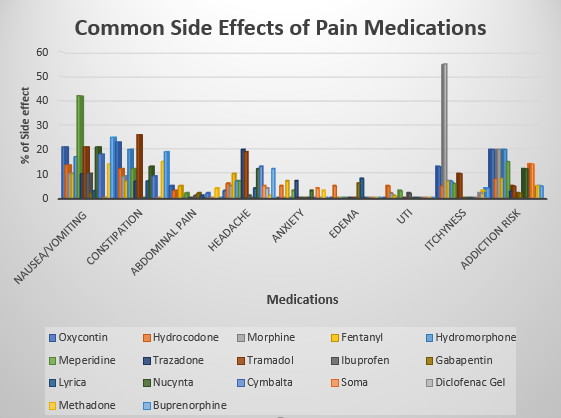Taking Pain Medications? Here Are Some Common Side Effects.

Pain medications were originally created and used to help patients in severe pain during surgery. Over time, pain medications have become more commonly prescribed postoperatively, as well. With these medications being used more frequently, more questions arise about their side effects.
Side effects are studied and reported throughout clinical trials and documented on all medication monographs in order to notify the patient population of the potential unintended consequences of the medication. The value of giving this information to the patient and provider allows the provider to work with the patient to weigh the risk to benefit ratio.
Unfortunately, this may mean trading one issue with another. For example, narcotics work best for alleviating pain, however, they have the highest risk of addiction compared to any other class of pain medications on the market. Every class of medications have similar side effects, but vary slightly from one another.

https://www.micromedexsolutions.com/home/dispatch/ssl/true
OPIOIDS
Beginning with opioids, the most common side effects are constipation, nausea, vomiting, addiction, sedation, itchiness, headache, abdominal pain, and anxiety/depression. Why do these side effects occur? Many of these medications are derived from morphine. Morphine binds selectively to the MU receptor, which is the primary receptor for pain relief in the brain. However, because this receptor does not only provide pain relief, but is also found throughout the body, it will trigger these other effects to occur.
NARCOTICS
In the chart above you can see that most of the narcotic medications have similar side effects, but the percent of which specific effect varies. This allows patients to get the pain relief they need while limiting certain side effects they may be more prone too. For example: if a patient has headaches in addition to chronic pain, they would be less likely to take hydromorphone, oxycontin, hydrocodone, tramadol, Nucynta, methadone, or buprenorphine.
Medications generally used for nerve pain (Gabapentin, Lyrica, and Cymbalta) work by slowing down the bodies nerve impulses. When this happens everything in the body generally slows down. Common side effects of these medications include constipation, edema, weight gain, headache, and nausea and vomiting.
Medications with the least side effects include topical products, like lidocaine patches/cream/gel and diclofenac gel/patch. Because these medications are not being ingested, the amount of side effects are limited to where the product is applied. Therefore, if a patient is having a hard time with reducing their pain without increasing the risk of side effects, a topical formulation may be their best option.
Consulting with your doctor about different options for your pain management may help achieve a better quality of life. The most important part of managing your health care is to be have open communication with your doctor and pharmacist.
Health care professionals rely on unique patient experiences to better tailor a patient’s medication therapy. Here at IWP, we have a team of pharmacists who can readily answer any questions regarding you medications and any potential side effects you may be experiencing. Give us a call today at 888-321-7945 or visit our Contact Us page with any questions.
Other Posts You Might Be Interested In
Subscribe to email updates
Stay up-to-date on what's happening at this blog and get additional content about the benefits of subscribing.


